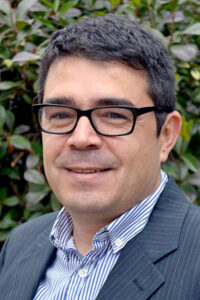Panel to discuss how precision medicine can move toward health equity

Precision health has made dramatic inroads in the diagnosis, treatment, and survival of many cancers. Those inroads have been focused largely in non-Hispanic white populations.
“Many communities, especially communities of color, have a very high cancer burden compared to whites, said Luis Carvajal-Carmona, PhD, University of California, Davis. “The incidence and mortality of many cancers are higher for people of color in this country.”
Carvajal-Carmona will co-moderate a panel discussion with Mariana C. Stern, PhD, USC Norris Comprehensive Cancer Center, and Sarki A. Abdulkadir, MD, PhD, Northwestern University, on Innovative Molecular Approaches and Models to Advance Precision Health Equity on Wednesday, April 14, from 3:30 – 4 p.m. EDT. The live discussion builds off of an On Demand session of the same name available now for viewing. Registrants can watch the session now and submit questions for the panel through a Q&A box available in the On Demand session.
“We know that factors affecting disparity are often interrelated,” said Tiffany Wallace, PhD, Center to Reduce Cancer Health Disparities (CRCHD). “Environmental, behavioral, social, clinical, cultural, and psychological factors are all directly influenced by structural and systemic racism to cause cancer disparities. Biological and genetic factors also play a role.”

How and how deeply biological and genetic factors affect cancer disparities remains largely unknown. Clinical studies, preclinical studies, and basic cancer research have traditionally been biased in favor of non-Hispanic whites. The Cancer Genome Atlas Program, which has characterized more than 20,000 primary cancer and matched normal samples across 33 cancer types, has just 12 percent Black, 3 percent Hispanic, and 0.2 percent American Indian samples, Carvajal-Carmona noted.
Researchers are starting to address those disparities. Multiple NIH grants are available for basic and translational research, Wallace said. NIH is also funding Specialized Programs of Research Excellence (SPOREs) through multi-project, multi-component P20 grants for translational research focused on prevention, early detection, diagnosis, and treatment. Planning grants are also available.
The agency is funding development of new models, including patient-derived xenograft mouse models (PDXs), genetically engineered mouse models, 3D human tissue model culture systems, and humanized mouse models. Cancer Moonshot funding is supporting PDX Development and Trial Centers Research Network (PDXNet) to develop models specifically from underrepresented minority communities.

One of those centers is developing organoid models of gastric cancer. Minorities are roughly twice as likely to be diagnosed with and die from gastric cancer compared with non-Hispanic whites, noted Nicole Coggins, PhD, University of California, Davis. Korean Americans are at five-fold risk.
The University of California Minority Patient-Derived Xenograft Development and Trial Center (UCaMP) is developing 200 PDX models for bladder, gastric, lung, and liver cancers. Sixty percent will come from URMs, largely Hispanic/Latinx and Asian, the largest minorities in California.
Early GC models show marked alteration in PI3K/AKT and CDK/cell cycle pathways in URM xenografts, Coggins reported. Organoid models developed from these xenografts identified high sensitivity to specific chemotherapeutic and targeted agents in vitro and in vivo.
“Many of these agents have been FDA-approved for other cancer types, but not gastric cancer,” Coggins said. “This targeted research is improving our understanding of genetic drivers and effective therapies specifically for minority patients. Our goal is to reduce cancer health disparities.”

Nora M. Navone, MD, PhD, The University of Texas MD Anderson Cancer, Houston, uses xenografts to identify molecular and other biologic factors driving prostate cancer in underrepresented minority populations.
Black men have double the prostate cancer (PCa) mortality than any other race or ethnicity, Navone noted. The MDA PCa PDX series has already identified important genetic differences. All PDXs from black patients had alterations in either BRCA1, BRCA2 and/or DNA repairome genes, and none exhibited the EMRSS-2ERG fusion commonly seen in White men.
“PDX-derived organoids are helping identify the dominant molecular alterations driving prostate cancer progression,” she said.
Kevin L. Gardner, PhD, Columbia University Irving Medical Center, New York, is pushing the limits of digital pathology to develop novel predictive biomarkers in breast cancer. Novel multiplex imaging platforms cannot only identify antigens, but their physical locations in nucleus, cytoplasm, and tumor microenvironment.

Cytoplasmic kaiso and LC3A/B are associated with an immune-suppressed tumor microenvironment, Gardner said, and also associate with race in a sample collection of 2,500 patient tumors. Using spatial geometry to define the tumor microenvironment produces a spatial intensity score (SIS) that predicts BRCA survival.
“This predictive potential may separate by race and other factors,” Gardner said. “We are learning what can be done with biomarkers associated with spatial information.”
[gap]
